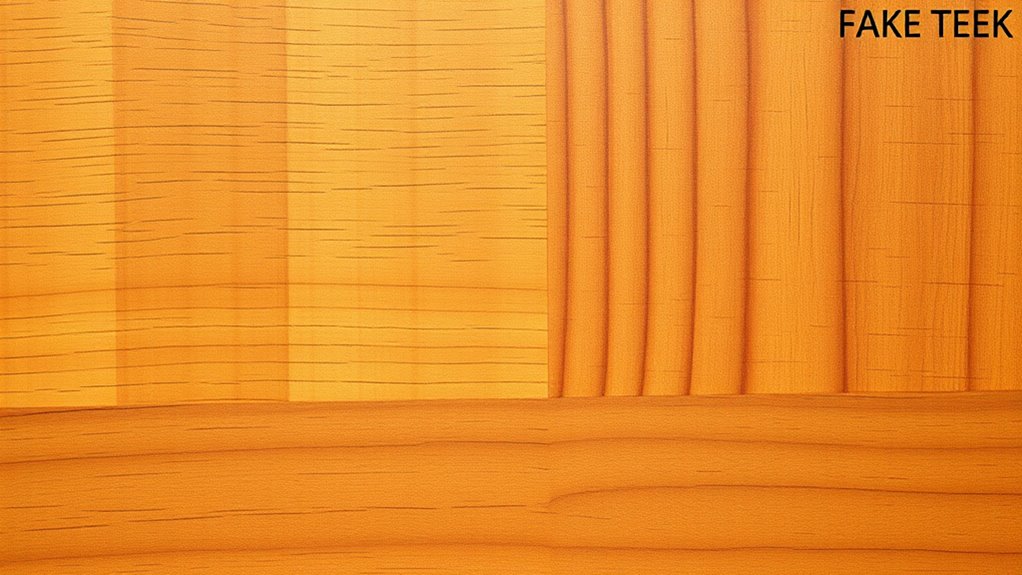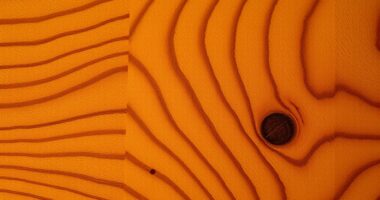To spot genuine teak, check its grain for natural swirls and irregularities, not uniform patterns. Feel its dense, oily texture and note a subtle woody scent—fake teak often smells chemical and feels lightweight. Observe the color for warm, consistent tones that age gracefully, and do a water test—real teak beads water and resists staining. Examine edges for tight, solid construction without glue or veneer seams. Keep exploring to uncover more distinguishing details.
Key Takeaways
- Genuine teak has an irregular, natural grain with swirls and interlocking patterns, unlike the smooth, uniform grain of imitations.
- Authentic teak displays a warm, golden brown to honey hue that ages gracefully, whereas fake versions often have uneven or overly glossy coloring.
- Real teak emits a subtle woody aroma and feels dense with a slight oily texture, while fake materials often smell artificial and feel lightweight or plasticky.
- Water resistance tests show genuine teak beads water or absorbs it slowly, unlike cheaper materials that quickly soak up moisture.
- Edges of real teak are tight, clean, and free from glue or veneer seams, whereas imitations may reveal layered construction or visible glue.

Teak is prized for its durability and beauty, but distinguishing genuine wood from fake can be tricky if you’re not familiar with its characteristics. One of the most reliable clues is examining the grain pattern. Real teak has a distinctive, irregular grain that varies from piece to piece. You might notice swirls, waves, or interlocking lines that create a natural, uneven appearance. When you run your fingers over genuine teak, the grain feels varied, with subtle ridges and valleys, unlike the smooth, plastic-like surface of imitations.
Furthermore, genuine teak often contains natural oils that contribute to its resistance against pests and weathering. Color consistency is another key indicator. Authentic teak exhibits a rich, warm hue, usually ranging from golden brown to deep honey tones. While some variation in color is normal, genuine teak generally maintains a consistent hue throughout the piece, with a natural luster that ages gracefully. Fake teak, especially the synthetic or veneer varieties, often displays uneven coloring or unnatural shades. It might have patches that look too uniform or overly glossy, betraying its manufactured origin. When inspecting, look for areas where the color seems artificially bright or uniform, which is a sign that the material isn’t real wood.
Additionally, the scent can serve as a clue: genuine teak has a subtle, woody aroma that’s hard to replicate. If you encounter a strong chemical smell or no scent at all, it’s likely not authentic. The texture also matters—real teak feels dense and solid, with a slight oily quality due to natural oils present within the wood. Fake versions often feel lightweight, overly smooth, or even plasticky, lacking that natural heft.
If you can, perform a simple water test. Genuine teak’s natural oils make it resistant to water absorption, so a few drops should bead up or slowly absorb without leaving a stain. Cheaper materials tend to soak up water quickly, showing their inferior quality. Also, check the edges of the wood; real teak has tight, clean-cut edges with no visible glue or veneer seams, while fake or veneer pieces often reveal layered construction or glue residue.
To verify authenticity further, consider examining the grain pattern under a magnifying glass to spot subtle imperfections typical of natural wood.
Frequently Asked Questions
Can Fake Teak Develop the Same Patina Over Time?
Fake teak generally won’t develop the same authentic patina during the aging process. Genuine teak‘s natural oils and dense grain allow it to age gracefully, creating a rich, silver-gray patina over time. If you have imitation teak, it might change color slightly, but it won’t develop that deep, natural patina like real teak. So, if you want authentic aging characteristics, invest in genuine teak to enjoy its true aging process and patina development.
Is Synthetic Teak More Resistant to Weather Than Real Teak?
When it comes to weather resistance, synthetic teak is often the go-to because it boasts superior synthetic durability, making it less prone to cracking or warping. Think of it as a tough nut to crack. While natural aging gives real teak a charming patina, it can also lead to deterioration over time. So, if you’re after low-maintenance, synthetic teak tends to stay looking good longer in the elements.
How Does the Weight of Genuine Teak Compare to Imitations?
You’ll notice that genuine teak is typically heavier than imitations because of its higher wood density, which contributes to its substantial material weight. This increased weight indicates a denser, more durable wood. When you pick up furniture or planks, genuine teak feels solid and hefty, unlike lighter, cheaper imitations that lack the same density. So, the weight is a reliable clue to distinguish authentic teak from synthetic or lower-quality alternatives.
Are There Eco-Friendly Ways to Identify Authentic Teak?
You can identify authentic teak eco-friendly by checking for natural harvesting practices and eco label certification. Look for labels indicating sustainable sourcing, which means the wood comes from responsibly managed forests. Avoid teak from illegal logging or harmful practices. When shopping, ask vendors about their sourcing methods, and choose products with verified eco labels. This guarantees you’re supporting environmentally conscious harvesting and getting genuine teak while protecting the planet.
Do Pricing Differences Reliably Indicate Teak Authenticity?
Pricing cues can sometimes be a mirror, reflecting the true quality of teak. Higher prices often hint at genuine, sustainably sourced wood, but they aren’t foolproof. Relying solely on cost can be deceiving, especially if brand reputation isn’t considered. You should also evaluate the seller’s credibility and craftsmanship. Remember, authentic teak’s value isn’t just in its price but in its durability and eco-friendly origins.
Conclusion
Remember, the true test of quality is in the details—”A penny wise, a pound foolish.” By paying attention to grain patterns, color, weight, and scent, you can confidently spot genuine teak amidst imitations. Don’t settle for less when you can choose durability and elegance that stand the test of time. Trust your eyes and instincts; after all, buying smart now saves you trouble later. Keep these signs in mind, and you’ll always make the right choice.







